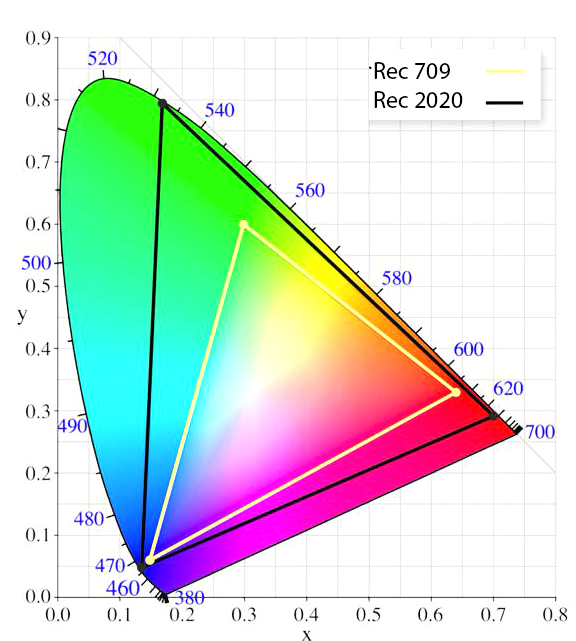
Viz Engine Administrator Guide
Version 3.12 | Published October 17, 2019 ©
High Dynamic Range (HDR)
High Dynamic Range (HDR), often in combination with wide color gamut (WCG), is a way to improve the colors shown on screens.
Supported Color Formats
These are the supported SDR/HDR color formats of Viz Engine 3.12 (or higher):
|
SDR |
HDR |
|
ITU-R BT.601 |
|
|
ITU-R BT.709 |
|
|
ITU-R_BT.2100 SLOG3 |
Those standards are mainly known as HDR10.
BT 2020
BT.2020 is a color space with a WCG. It covers a larger subset of visible colors than, for example, BT.709. Currently, all HDR settings in VizEngine use the BT.2020 color space with ten bits per component (bpc) color depth.

Color spaces
PQ (Perceptual Quantization)
PQ is standardized as SMPTE ST 2084. PQ defines the luminance levels up to 10,000 cd/m2 (nit).
HLG (Hybrid Log-Gamma)
HLG provides a relative value tied to the gamma and logarithmic curve. This system supports practical luminance levels from 1,000 up to 2,000 cd/m2. HLG is compatible with conventional SDR systems, so TVs that do not support HDR can reproduce HDR.
SLOG3
S-Log is a gamma curve with a wide dynamic range optimized under the assumption that grading is performed in the post-production process. S-Log3 allows for better reproduction of gradation characteristics in shadows and the mid-tone range than previous S-Log versions. It has characteristics closer to those of scanned film.
Requirements
-
Matrox System Topology video card (X.mio3 or DSX LE4).
-
1080p or UHD resolution.
Limitations
-
Expect higher delays when using HDR in UHD environments due to increased processing requirements. In that case, the ringbuffer needs to be turned on, but can be set lower than the default value of 5. (e.g. =1)
-
Rendering in HDR requires a lot of GPU power. At least a NVIDIA P6000 is required.
Configuration
Most of the settings required for HDR are not yet accessible through the GUI. These settings must be changed in the Viz Engine config file.
Output
-
Set the output format to 1080p or UHD.
-
Set the colorimetry of the output: output_colorimetry = ITUR_BT_2100_HLG.
-
Set the bits per component of the output (can be eight or ten): output_bpc = 8.
Other options are ITUR_BT_2020, ITUR_BT_2100_PQ, and ITUR_BT_2100_SLOG3. Specifying ITUR_BT_601 or ITUR_BT_709 is possible, but redundant. BT.601 is always used for SD resolutions (NTSC, PAL) and BT.709 is the default value for all other resolutions.
Input
Currently, only live and clip input are supported on X.mio3 video cards.
-
Set the input to the same resolution and framerate as the output.
-
Set the colorimetry (live_colorimetryX or clip_colorimetryX, respectively) to the same colorimetry as the output.
-
Set the bits per component of the inputs (can be eight or ten): live_bpcX = 10 or clip_bpcX = 10.
-
Use the input as DVE.
Currently, no conversions between different frame rates or resolutions are supported when HDR is used. Clip input channels can only play clips that have the same resolution.
Renderer output
-
Set the renderer to use 16 bits per channel: bits_per_channel = 16.
-
Set the color space conversion (CSC) to shader: rgb_2_yuv = 1.
Note: When HDR is enabled, shader CSC and GPU direct can be used in combination. Ringing Filter is not available in HDR. Also, rendering for HDR requires much more GPU power than SDR does.